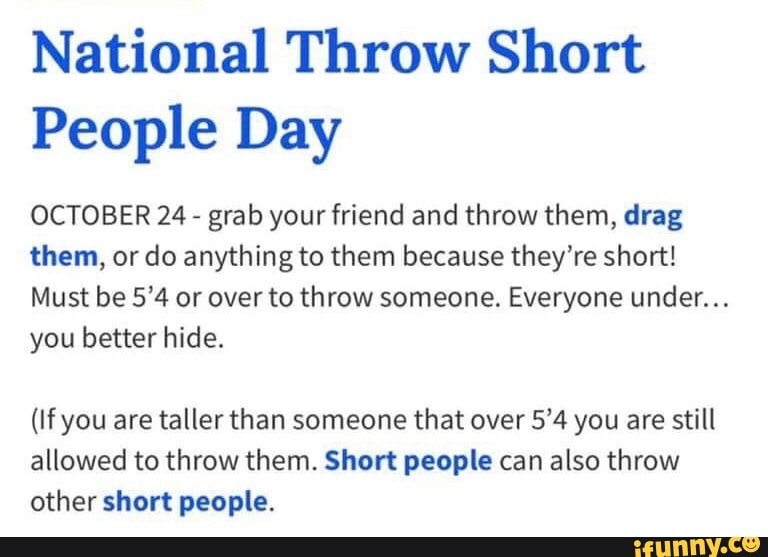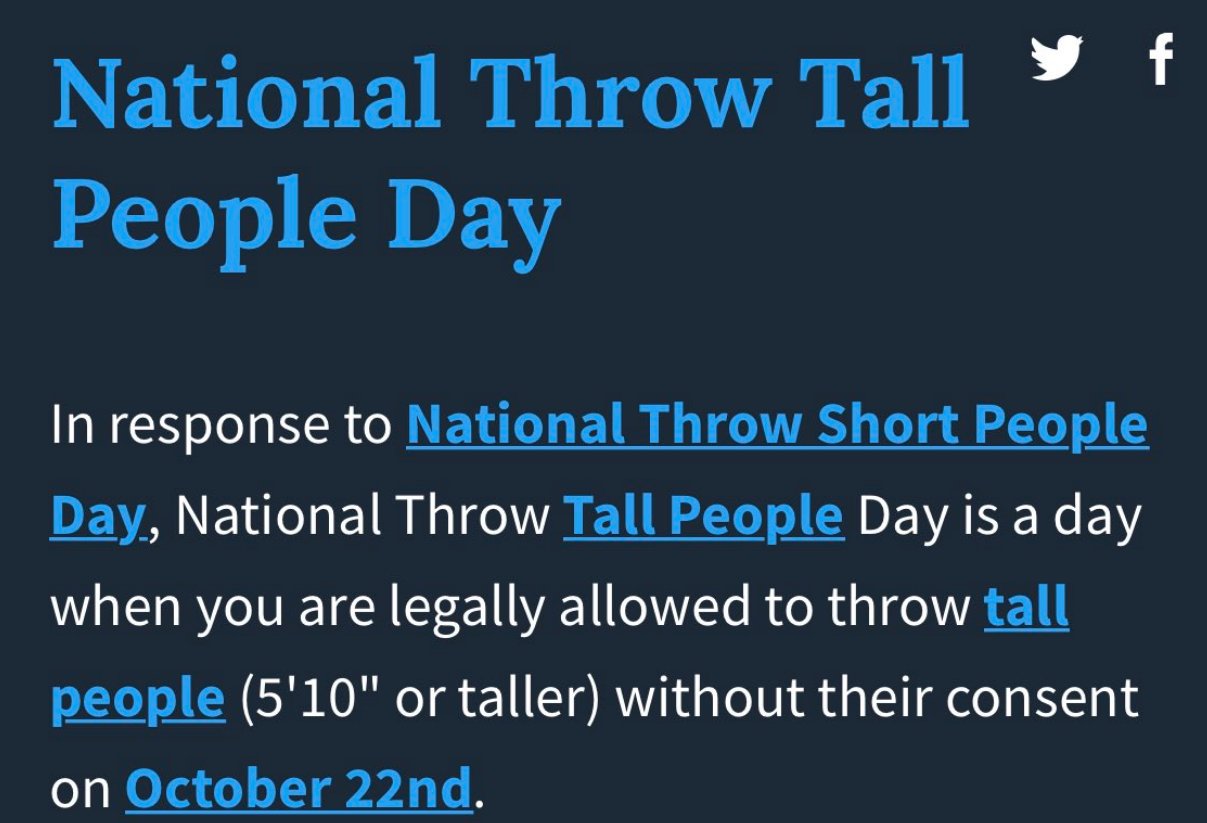Is there a day dedicated to the whimsical act of "throwing" shorter individuals, and if so, what's the story behind it? Indeed, there is a quirky internet trend known as "National Throw Short People Day," a phenomenon that has sparked both amusement and contemplation across the digital landscape.
The world of online trends is a vibrant and often unpredictable place, where fleeting fads can capture the collective attention of millions. One such trend, which has periodically surfaced on social media platforms, is the concept of "National Throw Short People Day." As the name suggests, this is a day humorously dedicated to the act of "throwing" shorter individuals. The premise, of course, is purely metaphorical, a playful take on the dynamics of height and social interactions. The origins of this trend can be traced back to the internet's penchant for creating and sharing humorous concepts, often rooted in everyday observations and social commentary.
While it's a lighthearted trend, it's essential to understand that "National Throw Short People Day" is entirely fictional and has no official recognition. Its primary purpose is entertainment, and it should not be taken as a call for any form of physical action. The beauty of the internet lies in its ability to connect people and foster communities around shared interests, even if those interests are as unusual as this particular theme.
The emergence of "National Throw Short People Day" offers an opportunity to delve into the broader context of online culture. The internet is a realm where creativity knows no bounds, and where users can freely express their thoughts and ideas. However, it's equally important to remember that this freedom comes with a responsibility to be mindful of the impact of our online actions and words. When engaging with trends, it is important to strike a balance between enjoying the humor and upholding the values of respect and empathy.
The trend's popularity highlights the complex dynamics of online social interactions. With the rise of social media and online communities, people are interacting in new ways, forming communities, and establishing norms and customs. These interactions may lead to the creation of new trends, like "National Throw Short People Day," that reflect the current social and cultural environment.
The very concept of "National Throw Short People Day" sheds light on height and societal perceptions. Society has, in many ways, placed a heightened emphasis on height. Throughout history, taller stature has been associated with authority, influence, and attractiveness. These social and cultural norms often cause biases and stereotypes related to height.
Despite its light-hearted nature, the trend does provide a chance to reflect on the need for inclusivity and to challenge biases based on physical attributes. It prompts us to acknowledge the diversity of human experiences and to treat each other with respect, regardless of how we may differ in size.
National Throw Short People Day originated as a lighthearted social media trend but has since evolved into a day of advocacy and celebration. The day aims to challenge stereotypes and prejudices against individuals of shorter stature and promote acceptance and understanding.
This is a prime opportunity to celebrate the unique gifts that short people bring. It's a great opportunity for those who are vertically challenged to come together and appreciate their unique strengths, including flexibility, agility and creativity.
In the U.S., the average height for men is 5'9" and the average height for women is 5'4", so people below those numbers are shorter than the average person and may want to observe December 22nd as national short person daya day that reminds everyone that good things often come in small packages.
Heres what the internet has to say about this peculiar day, the 24th, and the 28th of October:
- "The 24th is National Throw a Short Person Day."
- "The 28th is Throw Your Shortest Friend Day."
The internet's fascination with the concept of "throwing" shorter individuals is often attributed to the humor it generates. The idea of a day where the tall can playfully "throw" the short is seen as a humorous exaggeration of height differences, sparking a sense of fun and lightheartedness.
The term "yeet" (or "yote") in the context of social media is often used to describe the act of throwing something, often humorously. This slang word has become quite popular in online circles. Given the trend's name, "yeeting" becomes associated with the act of throwing shorter individuals. Phrases like "I can't wait to yeet some dwarfs!" illustrate the trend's playful, sometimes irreverent, tone.
While the concept might seem harmless, its worth examining the potential downsides. The popularity of this trend has led to its frequent mention on social media platforms. However, the concept of "National Throw Short People Day" raises questions about the impact of such online humor on social perceptions and empathy. While the trend might be light-hearted, it's essential to remember that this is all metaphorical, not to be taken literally.
In a digital age, humor and sarcasm frequently go hand in hand. Trends like "National Throw Short People Day" are a clear example of how the internet loves to use humor and sarcasm. These tactics add another layer of nuance to online communication and often influence how a concept is shared and interpreted.
This peculiar day encourages users to engage with this trend with a focus on the comical. Using these tactics helps ensure that the concept remains playful and lighthearted. The use of humor also influences the reach of this trend and adds a fun aspect for its followers.
The trend can be a reflection of modern internet culturequirky, exaggerated, and sometimes polarizing. While it might bring laughter to some, its crucial to remember the value of empathy and respect.
Here's a look at some related terms and themes associated with this online phenomenon:
- Heightism: A form of discrimination and prejudice based on height.
- Social Media Trends: The dynamic landscape of online interactions where various concepts and ideas emerge and gain traction.
- Cyberbullying: The act of harassing, threatening, or intimidating someone using digital media.
The concept of "National Throw Short People Day" acts as a unique lens, as it highlights the way trends emerge and evolve in the digital realm. It encourages all of us to appreciate the various aspects of social media and consider the potential effects of the content that we encounter and share.
Here are some film titles to consider on national short person day:
- The Hobbit
- Willow
- Elf
The internet is a creative space and as the "National Throw Short People Day" shows, it can also be a place where humor can spread quickly. While we celebrate this humorous day, it is important to treat others with respect and compassion.
| Feature | Details |
|---|---|
| Name of Event | National Throw Short People Day |
| Primary Dates | October 21st, October 24th, and October 28th, December 22nd |
| Core Concept | A humorous internet trend focused on the metaphorical "throwing" of shorter individuals, typically marked by playful online engagement and discussions around height. |
| Origins | Emerged as a lighthearted social media trend, evolving from humorous online commentary and user-generated content. |
| Associated Themes | Humor, online culture, height and perception, social interaction, internet memes. |
| Social Media Presence | Active on platforms such as Twitter, TikTok, and various internet forums, with hashtags and related content. |
| Interpretation | While the concept is purely metaphorical, it prompts conversations about height and social dynamics, reflecting the quirky nature of internet culture. |
| Objectives | Primarily for entertainment, but the trend also brings awareness to height-related stereotypes, prejudices, and the value of respect and empathy. |
| Celebration | Celebrated through the creation and sharing of humorous content, participation in related discussions, and possibly organizing related activities. |
| Impact | Provides a platform for lighthearted engagement while encouraging users to reflect on social dynamics, online behavior, and the influence of social media on communication. |
| Controversies | Raises concerns about the potential for online humor to perpetuate stereotypes and impact social sensitivity; careful attention is needed when making, and sharing online content. |
| Underlying Message | Underlines the significance of thoughtful online participation and the importance of approaching online engagement with empathy and respect. |
| Examples | Internet memes, humorous comments on social media platforms, and discussion threads are examples of content. |
| Relevance | Provides a distinctive lens for understanding how trends emerge and spread in the digital world and considers the impact of online interactions. |
| Key Principles | Playful engagement, responsible online behavior, and reflection on internet trends. |
| Related Term | Heightism: Discrimination or prejudice based on height. |
| Reference | Example Website |
Remember, as you traverse the digital landscape, keep in mind the power of respectful and thoughtful communication. It is not a day for physical action but rather, a moment to contemplate the impact of online trends and the importance of fostering a positive and inclusive digital environment.


